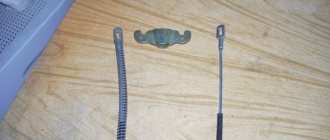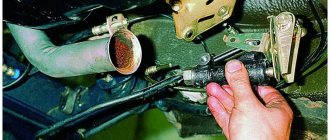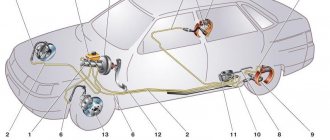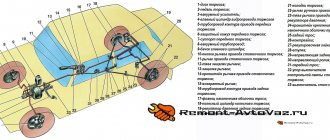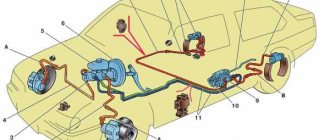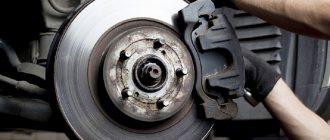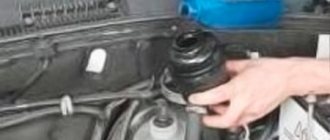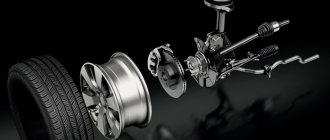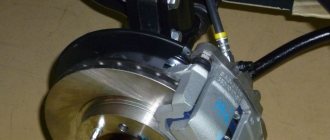A model of simplicity and reliability today, and a luxury item 30 years ago, the VAZ 2107 seems to never get old. It is from a series of those cars that have become a lifesaver for those who need reliable and inexpensive wheels, and over the 30 years of production it does not think of falling in price.
At one time it was one of the fastest cars in the country, which could only be equaled by the Moskvich 2140, and in terms of comfort it had no equal. In maintenance, just like all other rear-wheel drive Zhigulis, this is a simple and unpretentious car. Today we’ll take a closer look at what could have stopped this speed king of the 80s – his own brakes.
Design of the VAZ 2107 brake system
It is necessary to bleed the brake system in four cases:
- Replacing brake fluid. Brake fluid has a limited service life. Over time, it absorbs moisture from the air, which can cause corrosion of the surface of the brake cylinders and their failure. Water also worsens the main property of brake fluid - it reduces the boiling point.
- The recommended service life of brake fluid on VAZ cars is 2 years, after which it is worth replacing it. This applies to standard glycol-based brake fluid.
- Troubleshooting the brake system. When replacing brake hoses and cylinders, brake fluid leaks and air enters the system. Therefore, after repair work, the VAZ 2107 brakes must be bled.
- Air ingress during operation. This manifests itself in deterioration in braking efficiency, a “soft pedal” or uneven braking of individual wheels.
For ease of work and to ensure free access to the brake cylinder fittings, you should use an inspection hole. The design of the front brake mechanisms requires removal of the wheels to bleed the brake system.
Before starting work, it is necessary to fill the brake reservoir to the maximum, and during bleeding, you must ensure that it is constantly filled with brake fluid. If you miss this moment, air will get into the working cylinder and you will have to start work again.
The procedure for each of the 4 working cylinders is as follows:
- Remove the protective cap from the fitting.
- Loosen the fitting using a spanner. If the fitting has not been unscrewed for a long time, significant effort may be required. You must be especially careful not to damage the edges, otherwise the work may become very difficult, even to the point that the brake cylinder will need to be replaced.
- Place the tube on the fitting and lower it into the brake fluid container.
Direct pumping is performed as follows:
- The “partner” sitting in the cabin, at the command of the “mechanic”, presses the pedal all the way.
- The “mechanic” unscrews the fitting half a turn so that the liquid, along with air bubbles, comes out into the container through the inserted tube. The brake pedal “sinks” to the floor.
- The “fitter” tightens the fitting, and the “partner” releases the pedal on command.
The procedure is repeated until no more air bubbles come out of the tube. During bleeding, the end of the tube must be constantly lowered into the brake fluid so that air does not enter the cylinder.
In this way, all four working brake cylinders are pumped. A certain sequence should be followed when bleeding the cylinders. They are pumped “from far to near”:
- Right rear.
- Left back.
- Right front.
- Left front.
After completing bleeding of each cylinder, it is necessary to tighten the fitting and put on the protective cap.
Bleeding the brakes of a VAZ 2107 is quite feasible at home and does not require expensive special tools and devices. No special qualifications are required either. Even a child can release and press the brake pedal at the “locksmith’s” command.
Often, owners upgrade the brake system by installing more efficient, high-quality and expensive parts. However, this does not change the bleeding method in any way and does not eliminate the need for periodic work to replace the brake fluid.
The design of the VAZ 2107 brakes takes us back to the times when the city of Tolyatti was a wasteland, the whole country drove Muscovites and Volgas with drum brakes, and only read about disc brakes in the “Their Morals” section of the Za Rulem magazine. Capitalists have been riding on luxurious cooled and ventilated disc brakes since the 30s, but this design innovation reached us only in the second half of the 60s, and then at the instigation of Fiat.
The hydraulic drive system of the domestic 2107 model uses DOT-4 brake fluid. Content volume – 382 ml. It is not necessary to change or add fluid during repairs. It may be needed if moisture gets in or changes color. Mostly on Zhiguli cars a complete fluid change is required every 3 years. The process itself comes down to pumping liquid through the system.
We carry out the work ourselves
If the brakes as a whole or their circuits are depressurized, the system is pumped. This phenomenon can occur after repairs or in case of brake failure. To pump them, you will need a pit. Otherwise, the front wheels of the car are dismantled to open access to the fittings. It is better to do this type of work with an assistant. Experienced auto mechanics know how to properly bleed brakes.
- vinyl pipes,
- plastic bottles,
- a specialized wrench for fittings,
- brake fluids.
You will also need a pump cap and adapter, a pipe 0.5 m long and 0.5 mm in diameter, and a clutch reservoir cover. These elements are connected to each other. Bleeding the VAZ 2107 brakes begins with assembling the following system. The wheel is installed on the wing, and the lid is removed from the tank. A homemade similar part is installed on it. Next, the cap and hose are connected to the tank and wheel. The cylinder valves are unscrewed one by one, starting from the right rear and ending with the left front.
Soft and stiff brake pedal
The normal position of the brake pedal of the 2107 model is when there are no jerks or dips when pressed, and no effort is required. At the same time, during the operation of the car, car owners are sometimes faced with the fact that the brake pedal manifests itself in a completely different way, that is, it becomes too tight or soft.
Such manifestations are unacceptable and indicate problems in the braking system. Therefore, prompt repairs are required. Often the pedal becomes soft when the system is too airy. This phenomenon is also called failure. The damage can be repaired by bleeding the brakes, that is, it is necessary to remove accumulated air from the system. The latter could have happened due to the following reasons:
- not enough fuel fluid in the expansion tank;
- sealing in the braking system is broken;
- damage to the brake cylinder.
At the same time, there is a situation where when pressing the pedal it requires excessive force, for which the vacuum booster (VA) is to blame. This mechanism creates a vacuum in the manifold (intake). The fact that the pedal is tight is indicated by a number of reasons:
- the VU air filter is clogged, therefore, it needs to be replaced;
- the VU valve body is jammed; the vacuum booster should be replaced;
- the VU diaphragm is damaged; replacement of the control unit is required;
- wear of the tip of the device; the tip needs to be replaced;
- incorrect operation of the check valve in the control unit; it is worth replacing;
- the seal is broken; the VU or check valve should be replaced;
- damage to the hose connecting the intake manifold and the intake manifold, or the tightening of the clamp in it is loose;
- increasing the size of cuff cylinders in brake cylinders; this happens when using poor quality fuel fluid.
A little theory
To transmit force, one of the properties of the fluid is used - its incompressibility. That is, when a force is created on a liquid, its volume does not change, and it acts as a transmitter.
A hydraulic brake drive is more practical than a mechanical or pneumatic one, but it has one drawback - if air gets into the fluid, the transmission of force will be significantly reduced. This is because air, like any gas, is compressible. As a result, the presence of air leads to a change in the volume of the liquid when creating force (due to gas compression). Because of this, the force is no longer transmitted to the actuators, since it is absorbed by the volume change.
It turns out that effective operation of the brakes on a VAZ occurs only until air enters the drive system. And this can happen for several reasons.
Dual-circuit braking system
True, this did not affect the maintenance of the brake system in any way. It was reliable and indestructible, and remained with the amplifier. And it worked great, except when the diaphragm wore out. The dual-circuit braking system was new for the domestic car enthusiast. Although the Muscovites 408 of the first years of production were produced with hydraulics, they still had antediluvian drum brakes, and, like on the GAZ 53, there was only one circuit.
This means that if any of the wheel working cylinders were damaged, the entire system would fail and become depressurized. VAZ cars were initially free from this drawback, since the brakes were divided into two circuits - front and rear. Therefore, if one of the wheels leaked, at least two could still brake. This is not much, but it affected the process of pumping the brakes, which we will talk about in more detail today.
Bleeding the brakes: step-by-step instructions
To better pump the brakes of the “Seven” you will need an assistant. One will be under the car and work on the brake cylinders, while the other presses the brake pedal inside the car. The following tools will be useful in your work:
- head for 8 and 10 caps;
- head for 8 and 10, open-end or for brake pipes;
- transparent container for waste;
- hose of the required diameter.
Pumping starts from the furthest tire from the GTZ, therefore, start from:
- right rear tire;
- left rear;
- right front;
- left front.
To bleed the rear tire brakes, go under the car. All work related to the front brakes is carried out after the tires have been removed in advance. Otherwise the procedure is identical:
- Remove the protective cap from the brake cylinder fitting. Loosen the fitting slightly with an 8 and 10 mm wrench.
- Connect the hose to the fitting and place the opposite end into a container.
- Press the brake pedal until hardness appears and keep it pressed.
- Unscrew the fitting half a turn. The fuel fluid will begin to flow out of the hose, the pedal is pressed to the floor. Do not release the pedal until the liquid stops oozing.
- Tighten the fitting and repeat the process until liquid and air come out of the tube.
- Repeat the manipulations with the remaining tires of the VAZ-2107. To bleed the front brake, simply remove the wheel.
- To complete the pumping, close the fitting with a rubber cap. During pumping, you should monitor the fluid level in the expansion tank. It is important that there is no air in the system.
Carrying out work on rear mechanisms on VAZ classic models
First, let's look at how to properly bleed the brakes on a Classic. To perform the operation correctly, it is necessary to take into account that on the VAZ-2106 or any other model, the brakes are dual-circuit. That is, the entire system is divided into two independent parts. This was done so that if one of the circuits depressurizes, the second remains operational and the car can stop. But it is important to understand that the separation into circuits occurs on the master cylinder, and if air enters the system due to lack of fluid, it will be in both components.
For all classic models, including the VAZ-2107 brakes, the circuits separate the front and rear wheel drives. This must be taken into account when it is necessary to bleed the brakes of a 2101 or another model.
By the way, if only one circuit is aired, then it is not necessary to bleed the second one, although it would not be superfluous to treat all mechanisms, both front and rear.
So, everything is prepared, and you can get started.
The sequence of actions is as follows:
- It is better to drive the car into a pit to make it easier to get to the fittings. At the same time, he is immobilized using a handbrake or wheel chocks;
- Remove the cap from the brake fluid reservoir, check the level, and if necessary, bring it to the maximum level;
- First, we bleed the rear brakes of the VAZ, since the entire operation is done from the brake mechanism, which is as far as possible from the master cylinder, that is, from the right rear wheel;
- We put the assistant in the driver's seat. We climb under the car ourselves, put the key on the fitting, and then put the prepared tube on it, the second end of which should be lowered into a container with a small amount of liquid poured into it. It is advisable to immediately tear the fitting out of place and immediately screw it back, even before pumping. This is done so that there is no hitch in the process due to a non-unscrewing fitting;
- We ask the assistant to press the brake pedal 5-6 times. At the same time, with each press the failure will be less and less - the drive is pumped with liquid, while air moves to the mechanisms. After downloading the system, the assistant should hold down the pedal - press and hold it;
- Unscrew the fitting half a turn, working fluid will begin to flow out of it. If a transparent tube is used, air bubbles will be clearly visible in it, and the pedal being held will begin to move down until it hits the floor. In this position, the assistant must hold it, at this time the fitting must be screwed back;
- This sequence of actions should be carried out for one mechanism 4-5 times to completely remove air;
- On the “classic”, the left rear wheel is pumped next (since they are combined into one circuit). But before that, you need to check the level of the tank and bring it to the maximum level. The sequence of actions is the same: pump the brakes and hold the pedal - release the fitting to drain the fluid with air (the pedal goes down) - tighten the fitting - pump again. And so 4-5 times;
Note that this sequence of actions is identical for all cars. The difference lies only in some design features of the system itself.
Brake bleeding devices
The plant officially recognized only one method of bleeding the brakes - the one described in the user manual. But inventive car enthusiasts found more and more new options for how to bleed the brakes on a VAZ 2107. In principle, two people needed to bleed the brakes. According to the old habit, when the line systems were unreliable, the brake cylinders were bulky and bulky. In the seven, it was possible to completely replace the brake fluid in 15 minutes, without any difficulties, even alone.
Why in this order?
Who the hell knows! All experts claim that it is necessary to pump the brakes on sevens in exactly this sequence, but no one gives a logical explanation. If you know, write in the comments, it’s interesting to discuss this topic.
Why start with the rear wheels? - because they are the farthest, you answer. Okay, but the contours of the rear and front are separated from each other by the piston cuffs of the master brake cylinder! The front circuit starts working first in case of braking, why not pump it first?
I will express my theory based on experience and observations. Since the second chamber of the master cylinder is responsible for the rear brakes, the last one along the piston stroke, it means that after pumping it, it will be easier to pump the first one. If you do the opposite, then it will be problematic to completely “expel” the air from the rear brake circuit. When pressing the brake pedal, the piston will compress the fluid in the first chamber, and you will not be able to feel with your foot the degree of elasticity of the pedal after pumping. There is a chance that not all the air will escape and the rear axle will not brake.
But in the family of front-wheel drive VAZs, the order is different, cross to cross. The chamber closest to the vacuum amplifier is pumped first, that is, vice versa. We will talk about this in detail in other articles.
How much and what kind of brake fluid should be poured into the VAZ-2107
Fluid replacement should be carried out according to the maintenance schedule. Any brake fluid contains a large number of additives that evaporate over time. The operating mode of the system is very complex, high temperature and pressure make themselves felt. All additives that affect the metal and rubber elements of the system evaporate.
Therefore, it is recommended to completely replace the fluid every 80-100 thousand kilometers. This is the maximum service life of additives that are present in brake fluids. Accordingly, you need to carry out bleeding during a complete replacement.
What if without an assistant?
You can bleed the brakes on a VAZ-2107 without an assistant, but to do this you will have to slightly modify the design of the expansion tank cap. You need to buy a new cover into which you install the fitting from a regular camera. Now you need to create pressure in the system - this can be done using a camera or tubeless wheel. Inflate using a compressor and do the following:
- Fill the expansion tank with brake fluid.
- Install a cover with a fitting on it.
- Connect the fitting on the cover and the chamber using a tube.
- In this case, there is no need to install spool valves inside - they will be superfluous.
- Carry out repairs following the brake bleeding sequence described above.
Do not forget to add fluid to the system, otherwise an air lock will appear in it. You will have to bleed the brakes again. The VAZ-2107 uses the brand of fluid “RosDot-3” or “RosDot-4”. Try to use only those fluids recommended by the manufacturer.
Bleeding the brakes of a VAZ 2107 requires that an assistant sits behind the wheel and, at the command of the mechanic who performed the replacement, responds to shouts of “pump!” actively pumping up pressure in the system to expel air from it. "Hold it!" - meant that the mechanic unscrewed the fitting and the air, along with the old fluid, came out through the tube. The pedal had to be at the very bottom before the “Start!” command was received. In this case, among the special devices for pumping it was necessary to have:
- container for pumping and draining old fluid;
- a nylon tube with such a diameter that it fits flush onto the fitting;
- a spanner for bleeding, so that it is convenient to unscrew the fitting;
- a tube tip (optional), which worked as a check valve and was taken from the washer reservoir.
Later, even on sale, in the heyday of cooperative trade, special caps for the brake fluid reservoir, in which a nipple from a tubeless tire was embedded. Hit of the late 80s. We'll tell you how to use it right now.
Brake hoses: replacement
If the car owner notices smudges resulting from tire wear, it is necessary to change the brake hoses. Technical literature says that hoses installed more than 3 years ago are prohibited from being used. The explanation for this is simple: firstly, rubber ages, and secondly, it is more susceptible to deformation.
In a VAZ-2107 car, brake hoses are located both at the front and at the rear. These components lead the fluid fluid to the working cylinders. Having found out that the rubber component requires replacement, you need to stock up on:
- screwdrivers;
- pliers;
- a set of keys;
- new hose;
- brake fluid.
- Remove the front tire from the desired side so that there is convenient access to the caliper.
- Unscrew the bolt securing the hose from the reverse side and remove it with copper washers.
- Unscrew the hose in the area of fixation to the brake pipe.
Brake bleeding valve
And the brakes were pumped with the help of this device in splendid isolation, without any assistants, and it was possible to pump the brakes better and faster. Together, of course, it’s more fun, but if time is of the essence, then a bleeding valve was used. The process of pumping brakes on a VAZ 2107 looks like this:
- The maximum amount of fluid is added to the brake fluid reservoir.
- Using a car pump, excess pressure is pumped into the system.
- A container for old fluid is installed under the rear right wheel.
- The tube is put on the fitting and one end is lowered into the container.
- The fitting is unscrewed and the liquid under pressure leaves the system on its own.
- If necessary, the operation is performed for all other wheels.
The only thing that was important was to monitor the fluid level in the tank. It should not fall below the minimum. This way you can bleed the brakes of a VAZ 2107 car alone. Change the brake fluid on time, good luck to everyone and smooth braking!
Necessary tool
The pumping process should be carried out with a partner, because... It will be difficult to do the work yourself. To get results when working independently, you will need the following tools:
- A hose suitable for the fitting on the wheels of the car;
- Set of keys and sockets;
- Brake fluid;
- A rag for cleaning dirt from the caps;
- Container for liquid accumulation;
- Spare fittings in case the old ones break off.
It is also worth knowing the procedure for bleeding the brakes on a VAZ 2114, because... When performing the procedure, you should start with the rear wheels.
Source

